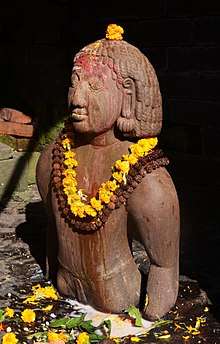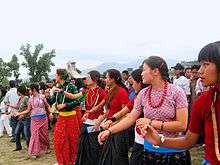Kirat Mundhum

Kirat Mundhum (also Kirati Mundhum), are the stories recited/sung by the shamans (called 'Fedangma/Samba') of the Kirati ethnic groups of Nepal: Limbu, Rai, Sunuwar and Yakkha peoples of Nepal, India, Myanmar and now practiced in the UK, China, USA and many other countries.[1] The practice is also known as Kirat Veda,[2][3] Kirat-Ko Veda[4] or Kirat Ko Ved.[5] According to some scholars, such as Tom Woodhatch, it is a blend of animism (e.g., ancestor worshiping of Sumnima/Paruhang and Yuma Sammang/Tagera Ningwaphumang),[6] Saivism,[7] .[7] It is practiced by about 3.1% of the Nepali population.[8] Before it was recognized as a religion on the Nepali census, 36% of the Kirati population claimed to follow the Kirat religion, but when it was recognized this figure increased to 73.9%, a 157% increase in the Nepali Kiratis.[1] also In addition to ancestor worship, Kiranti people also worship Mother Nature.
Religious texts
It has the religious scripture and folk literature of the Kirat people of Nepal. All four Kirats (Limbu, Rai, Sunuwar and Yakkha) have slightly different religious texts. Religious texts means the power of great strength Mundhum in the Limbu language[9], Mewahang rai call it muddum, Yakka rai as mintum, Sunuwar as mukdum among Kulung rai as ridum and Chamling rai as dum.[10][11][12] It covers many aspects of the Kirat culture, customs and traditions that existed before Vedic civilisation in South Asia.[13][14][15][16]
The religious texts for each tribe consists of customs, habits, rituals, traditions, and myths passed down from the Kirati tribe's ancestors. Religious texts serve, in a way, as customary laws which guide Kirats in their daily lives.[17] Their religious texts also distinguishes each Kiranti tribe from other Kirati and non-Kiratis as well.[17]
Practices
Kirats practice shamanism and their rituals are mostly related to the worship of mother nature, ancestors, sun, moon, wind, fire and main pillar of house. Almost all sacred rituals, in Rai, are performed by nakchong, the Rai tribal priest. Similarly Limbus have phɛdɑŋmɑ/bɑ, yɛbɑ/mɑ, sɑmbɑ/mɑ to perform rituals accordingly. Their supreme deity Tagera Ningwaphuma: tɑgɛrɑ niŋwɑphumɑ is personified as Yuma Sammang as female and Theba Sammang as male in earthly form. Some Limbus have their own distinct form of worship known as Yuma Sammang is mother of all the Limbus their follower are Yumaism; they venerate a supreme goddess.
Festivals

All four Kirats celebrate some similar and different festivals throughout the year. Some common festivals are Udhauli, Ubhauli and New year Yele Sambat (Maghe Saktanti).
Sakela is the main festival of Khambu Kirat [Rai], in this festival they worship mother nature and their Ancestor's [who is believed to be staying in their Chulla (fire place build by three stone, each stone has a unique meaning) and garden]. This festival is celebrated twice a year distinguished by two names Ubhauli and Udhauli. Sakela Ubhauli is celebrated during Baisakh Purnima (full moon day, which lies in the month of Baisakh in calendars of the Indian Subcontinent.) and Sakela Udhauli is celebrated during the full moon day in the month of Mangh. In Ubhauli they prey for the goodness of family and good weather for cultivation and in Udhauli they thanks the mother nature and ancestor for their blessing and good harvest. In both Ubhauli and Udhauli they sacrifice a rooster and worship by Ginger, Rice, homemade alcohol, and tree resin (resin is put in the burning coal for fragrance) and conduct a Sakela dance. In this dance they performs all the daily life activity ( example planting rice, harvesting etc.) and also try to copy the behavior of animals and birds which are part of their day to day life. The Limbu Kirat celebrate udhauli Chasok Tangnam on the day of Mangsir Purnima and Ubhauli (Yokwa Tongnam)in the month of Baisakh. Other Kirats (Yakkha and Sunuwars) also celebrate in their own way. Sakela celebration is the prayer to Goddess of Nature for good crops and protection from natural calamities.
The celebration of Sakela is also known as Chandi Nach Murat. On Chandi Nach, they worship Durga, who is known to them as Chandi, or Chandika.[18] (Worship of Durga among the Himalayan Kiratas is arguably written in the Harivamsha Purana.[19]) Durga Puja is still performed by a few Kirants.[20]
Tihar is another festival that was added first in the Veda. It is also known as Deepavali and Lakshmi Puja.[20]
See also
References
- 1 2 final layout pdf.p65
- ↑ p. 56 Kiratese at a Glance By Gopal Man Tandukar
- ↑ p. xxv A Grammar of Limbu By Geordefine sungge van Driem
- ↑ Problems of Modern Indian Literature by Statistical Pub. Society: distributor, K. P. Bagchi
- ↑ p. 323 Kiratas in Ancient India By G. P. Singh, Dhaneswar Kalita, V Sudarsen, M A Kalam
- ↑ "History and Culture of the Kirat" by I.S.Chemjong
- 1 2 p. 535 Nepal By Tom Woodhatch
- ↑ "Archived copy" (PDF). Archived from the original (PDF) on 2013-04-18. Retrieved 2012-11-01.
- ↑ Schools as Zones of Peace in Nepal By Isabelle Duquesne LIT Verlag Münster, 12 Jan 2016
- ↑ Page 45 Contemporary Society: Concept of tribal society By S. N. Ratha, Georg Pfeffer, Deepak Kumar Behera, 1997
- ↑ P.6 European Bulletin of Himalayan Research, Issues 17-19 By Südasien Institut, 1999
- ↑ Hardman, Charlotte E. (December 2000). John Gledhill; Barbara Bender; Bruce Kapferer (eds.), eds. Other Worlds: Notions of Self and Emotion among the Lohorung Rai. Berg Publishers. pp. 104–. ISBN 978-1-85973-150-5.
- ↑ Dor Bahadur Bista (1991). Fatalism and Development: Nepal's Struggle for Modernization. Orient Longman. pp. 15–17. ISBN 81-250-0188-3.
- ↑ Cemjoṅga, Īmāna Siṃha (2003). History and Culture of the Kirat People. Kirat Yakthung Chumlung. pp. 2–7. ISBN 99933-809-1-1.
- ↑ Cultures & people of Darjeeling
- ↑ Gurung, Harka B. (2003). Trident and Thunderbolt: Cultural Dynamics in Nepalese Politics (PDF). Nepal: Social Science Baha. ISBN 99933-43-44-7. OCLC 57068666.
- 1 2 p. 65 Culture, Creation, and Procreation By Monika Böck, Aparna Rao
- ↑ p. 76 Kiratas in Ancient India By G. P. Singh, Dhaneswar Kalita, V Sudarsen, M A Kalam
- ↑ p. 195 Ancient Communities of the Himalaya By Dinesh Prasad Saklani
- 1 2 p. 108 Politics of Culture:A study of three Kirata communities in the Eastern Himalayas by T.B. Subba